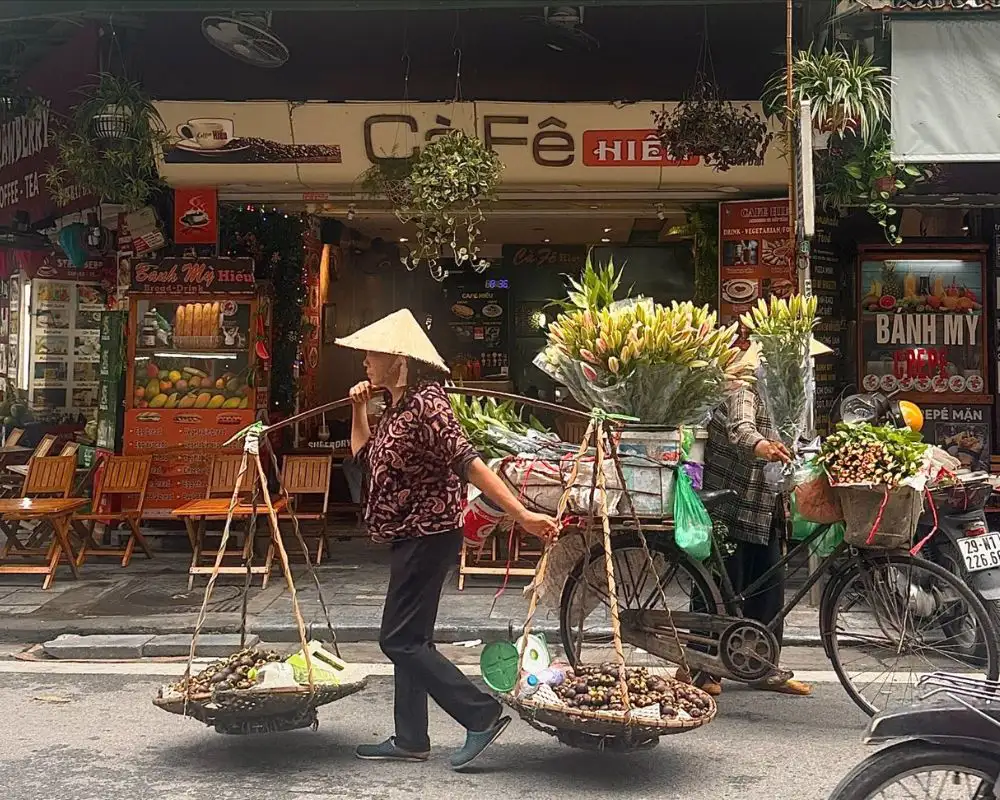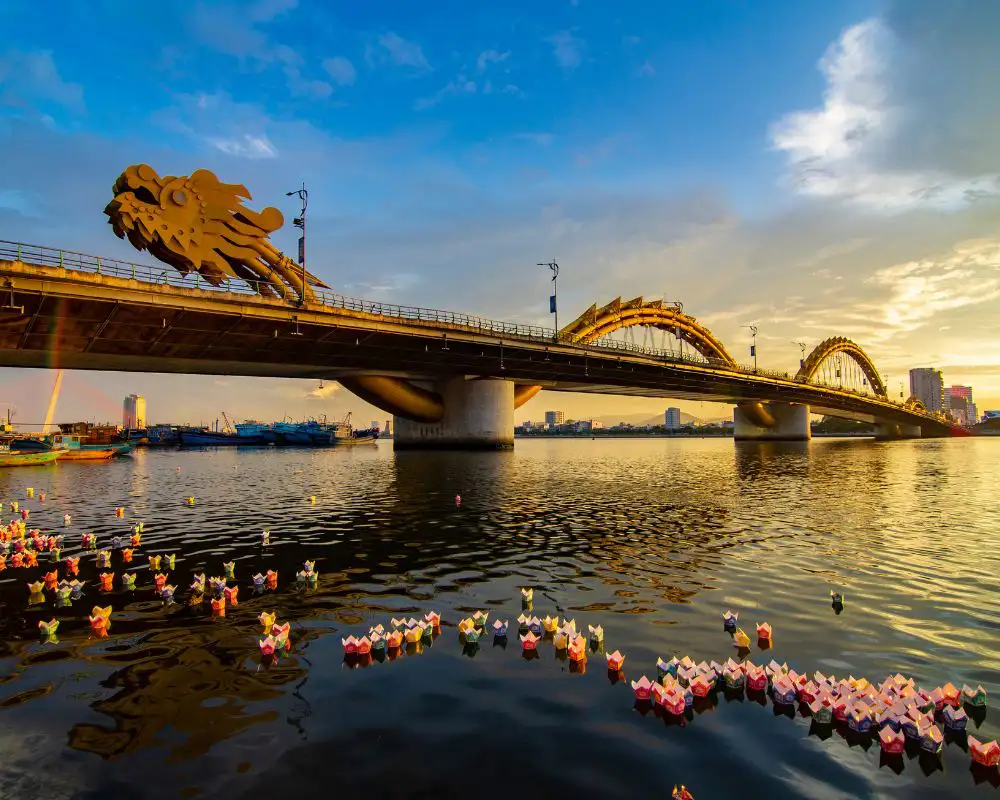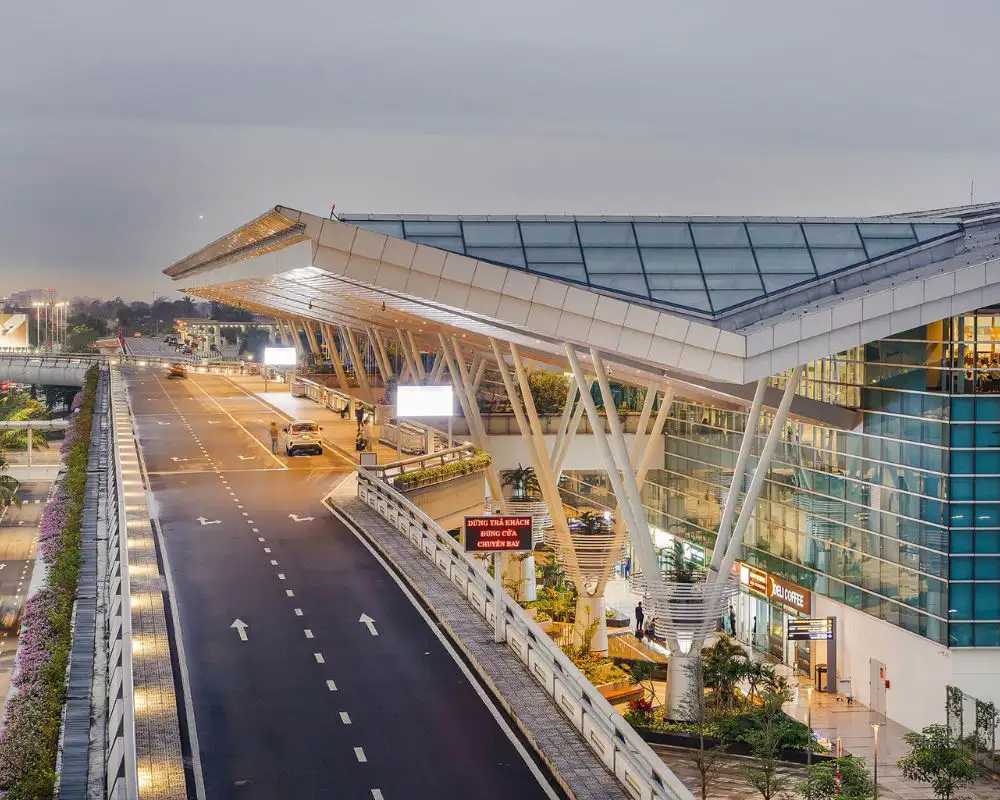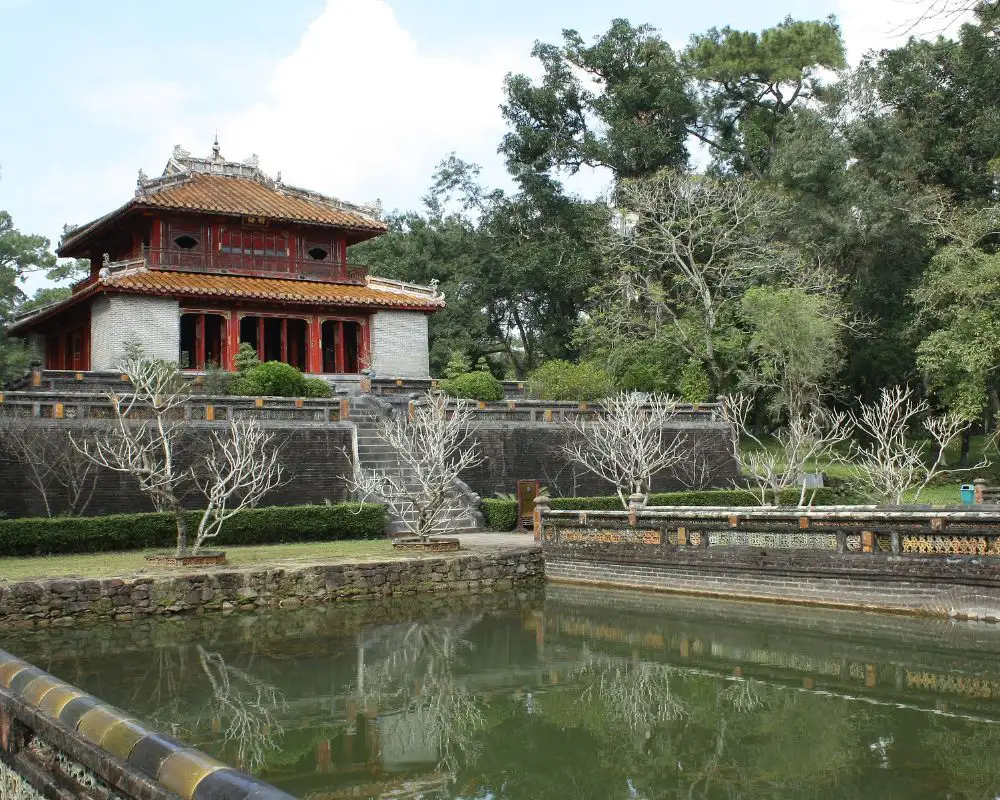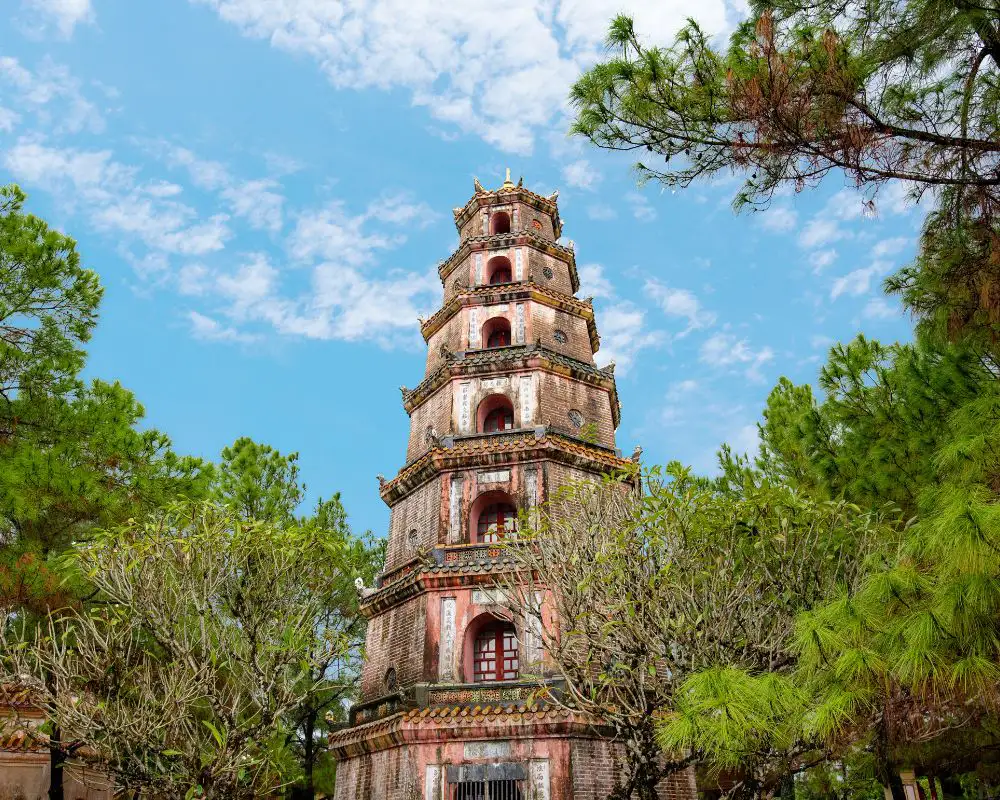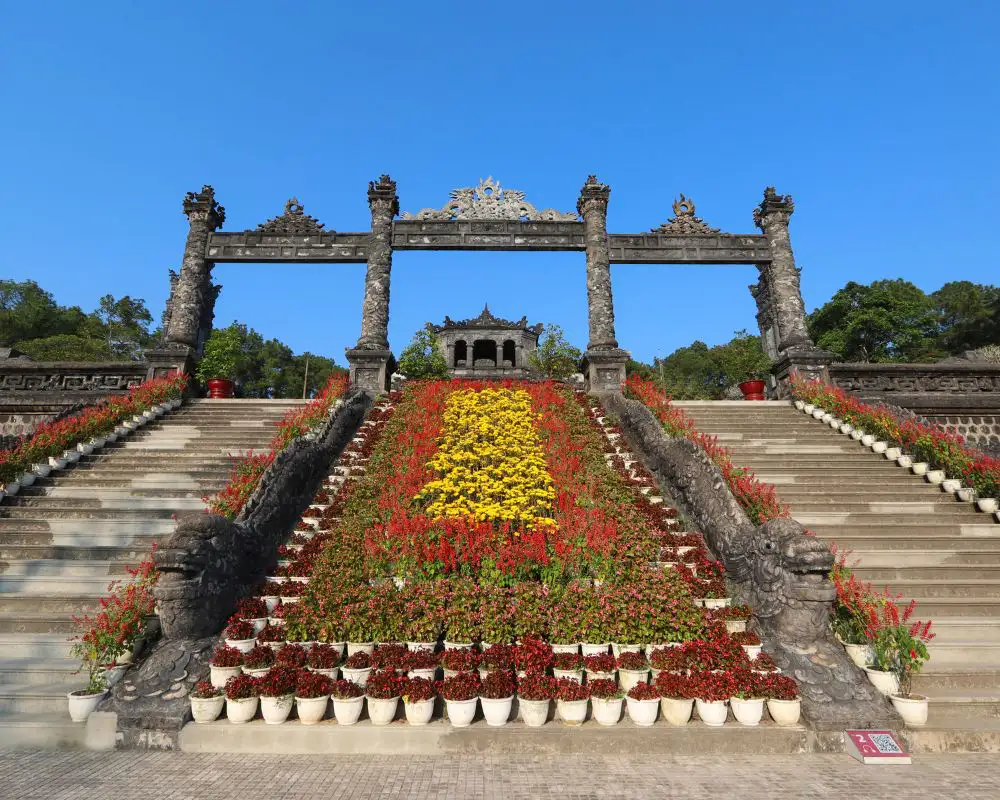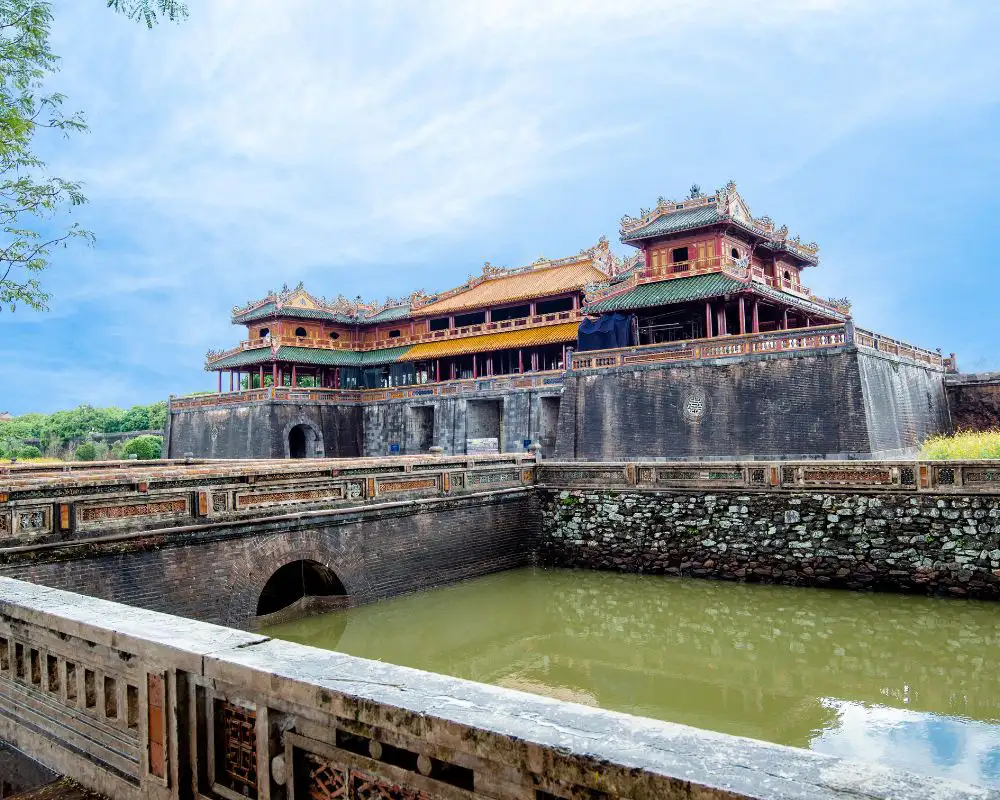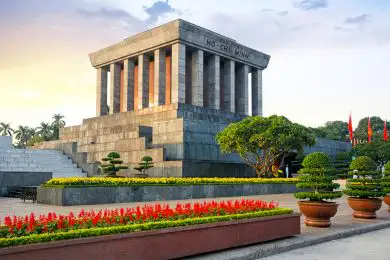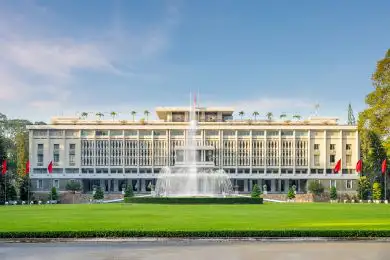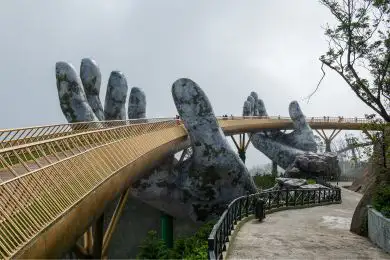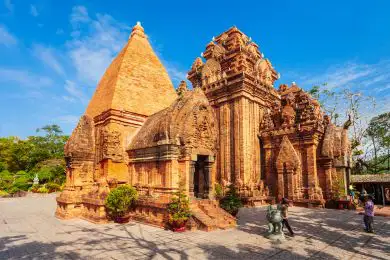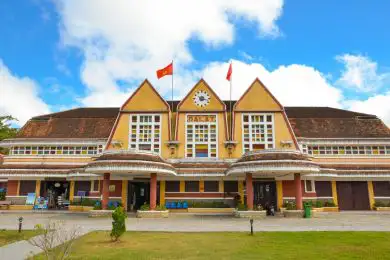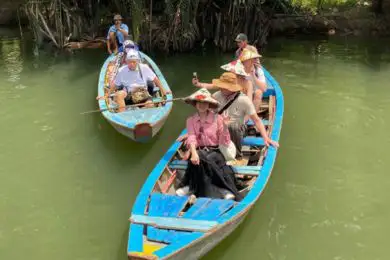Welcome to the enchanting world of Hue Imperial City, where history comes alive through the stories and legacies of the Nguyen Dynasty. Spanning 143 years of rich cultural heritage, this UNESCO World Heritage Site is a treasure trove of architectural marvels and historical significance.
While exploring on your own can be fascinating, experiencing Hue Imperial City with a knowledgeable guide elevates your visit to a whole new level.
Vietnam Trails Travel’s guided Hue tours offer you an immersive journey, weaving together the intricate tapestry of Vietnam’s last royal dynasty. Join us to delve deeper into the past, uncover hidden gems, and truly appreciate the grandeur and complexity of this historical wonder.
Introduction about Hue Imperial Citadel
Hue Imperial City, a UNESCO World Heritage Site, is a treasure trove of Vietnamese history, culture, and architecture. Located in the central region of Vietnam, this ancient city was the political, cultural, and religious center of the Nguyen Dynasty, the last ruling dynasty of Vietnam. Enclosed within its grand walls are palaces, temples, gardens, and a wealth of historical artifacts that tell the story of Vietnam’s imperial past.
- Address: Hue, Thua Thien Hue
- Houring open: 7:30 AM–5 PM
- Phone: 0234 3523 237
- Hue imperial city Entrance fee:
- Adults: 200,000 VND
- Children : 40,000 VND ( 7 to 12 years old)
History of Hue Imperial City
The Imperial City of Hue traces its origins back to the early 19th century when Emperor Gia Long established it as the capital of the Nguyen Dynasty. Influenced by the ancient city of Beijing, the construction of Hue began in 1804 and took nearly 30 years to complete. The city was strategically positioned along the banks of the Perfume River, symbolizing a blend of natural beauty and political power.
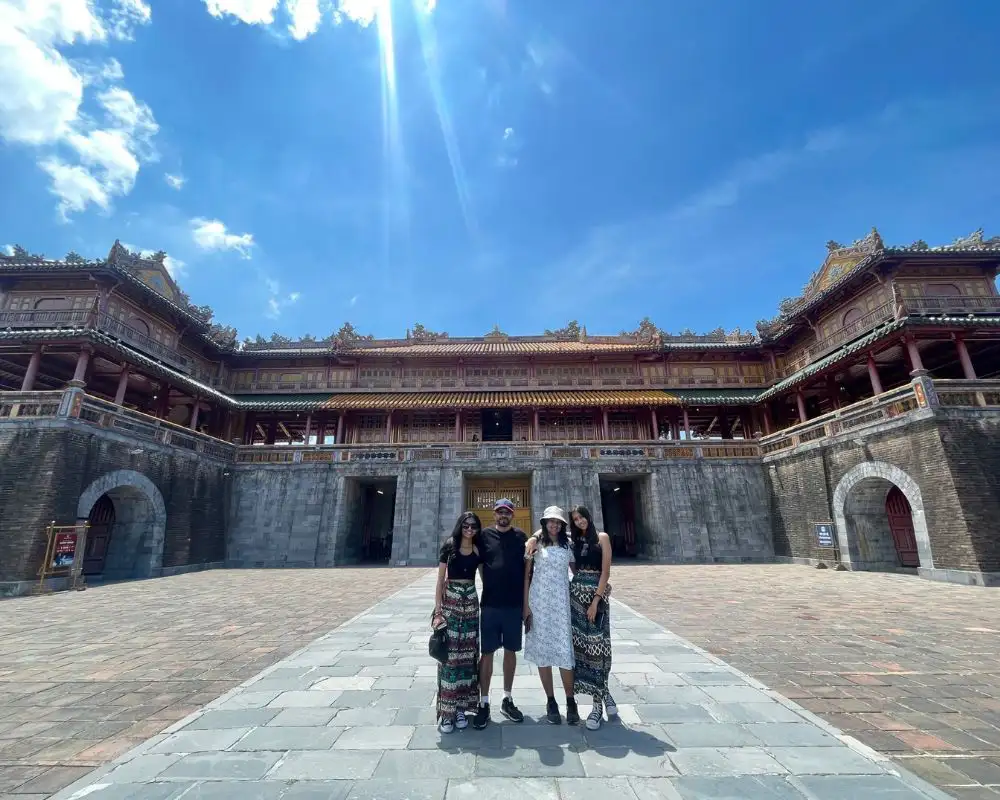
Over successive reigns, the city expanded and flourished. Each emperor contributed to its development, adding new structures, renovating existing ones, and enhancing its cultural and ceremonial importance. By the mid-19th century, Hue had become a vibrant hub of Vietnamese art, literature, and politics.
Read more: Top 15 Best Things Must Do in Hue
Must-See Attractions at Hue Citadel
1. Thai Hoa Palace
Thai Hoa Palace, also known as the Hall of Supreme Harmony, was constructed in 1805 during the reign of Emperor Gia Long. It served as the ceremonial hall for important state events, including the emperor’s coronation, royal birthdays, and diplomatic receptions.
The palace is an architectural masterpiece, featuring traditional Vietnamese design with a grand wooden structure supported by 80 massive ironwood columns. The roof is adorned with intricate dragon and phoenix motifs, symbolizing imperial power and prosperity.
Thai Hoa Palace was the political heart of the Nguyen Dynasty, where the emperor conducted official ceremonies and received foreign envoys. The palace’s grandeur reflects the might and prestige of the Vietnamese monarchy.
2. Ngo Mon Gate
Ngo Mon Gate, the main entrance to the Imperial City, was built in 1833 under the reign of Emperor Minh Mang. It served as the primary gateway for the emperor and his entourage during official processions.
The gate is a stunning example of Nguyen Dynasty architecture, with a multi-tiered pavilion featuring five entrances. The central door was reserved exclusively for the emperor, while mandarins and military officials used the two adjacent doors.
Ngo Mon Gate played a vital role in royal ceremonies and state functions. Here, the emperor would appear to address his subjects and oversee important events, such as the proclamation of new laws and decrees.
3. The Mieu Temple
The Mieu Temple, constructed in 1821 by Emperor Minh Mang, is dedicated to the worship of the Nguyen emperors. It is one of the most sacred sites within the Citadel, housing ancestral tablets and altars for the past emperors.
The temple complex consists of several halls and courtyards, each meticulously designed with traditional Vietnamese elements. The main hall, adorned with intricate carvings and decorations, houses the ancestral tablets of the emperors.
The Mieu Temple is the focal point for ancestral worship within the Citadel. It is where important rituals and ceremonies are conducted to honor and pay respects to the Nguyen emperors, reflecting the deep cultural and spiritual significance of the site.
4. Forbidden Purple City
The Forbidden Purple City, located within the Imperial City, was the emperor’s and his family’s exclusive residence. Its layout follows traditional Vietnamese principles, with a central axis and symmetrical structures.
The Hue Forbidden Purple City contains several important buildings, including the emperor’s private residence, administrative offices, and ceremonial halls. The Can Chanh Palace, the Kien Trung Pavilion, and the Queen Mother’s residence are key structures.
As the heart of the imperial court, the Forbidden Purple City was the center of political and administrative activities. It was strictly off-limits to ordinary citizens, emphasizing the emperor’s divine status and authority.
5. Dien Tho Residence
Dien Tho Residence, built in the early 19th century, was the living quarters of the empress dowagers. It served as a serene retreat for the queen mothers and other female members of the royal family.
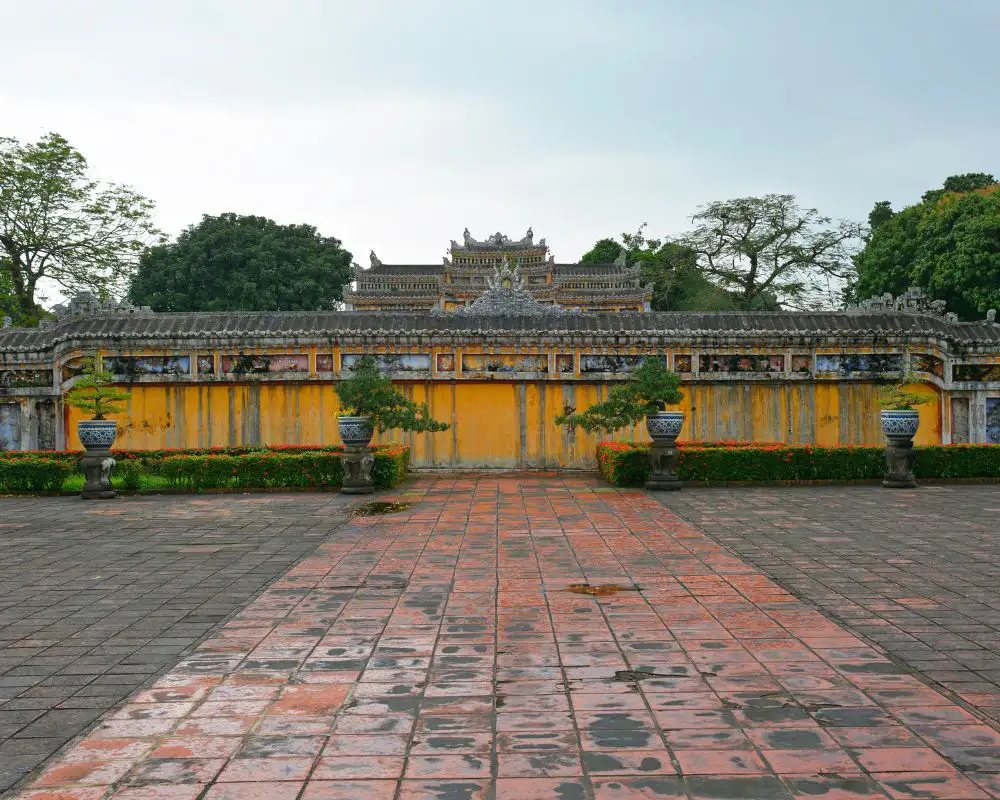
The residence features elegant traditional Vietnamese architecture, with peaceful courtyards, lush gardens, and well-preserved buildings. The tranquil environment provided a private sanctuary for the royal women.
Dien Tho Residence played a crucial role in the lives of the empress dowagers, offering them a place of comfort and seclusion. It is a testament to the respect and reverence accorded to the queen mothers within the imperial court.
6. Duyet Thi Duong Theatre
Duyet Thi Duong Theatre, established in 1826, is one of the oldest surviving traditional Vietnamese theatres. It was a venue for royal performances, including classical Vietnamese opera and other cultural events.
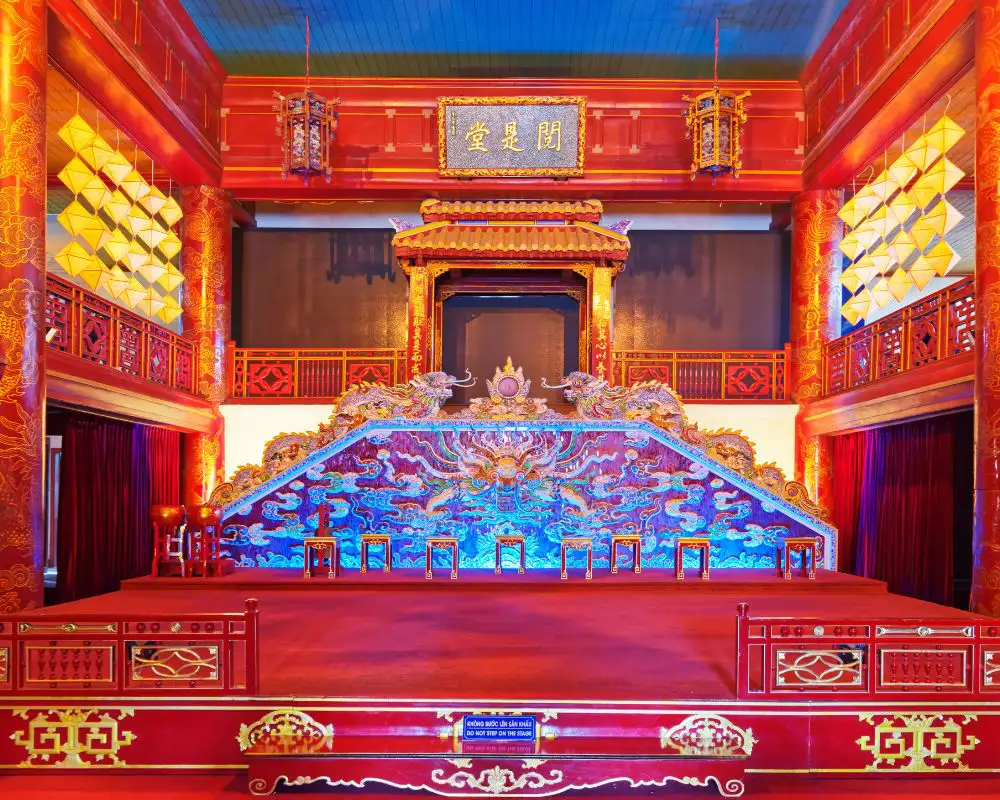
The theatre hosted a variety of performances, ranging from traditional music and dance to dramatic plays. These performances were an integral part of court life, reflecting the rich cultural heritage of the Nguyen Dynasty.
Duyet Thi Duong Theatre remains a symbol of Vietnam’s artistic and cultural legacy. It continues to host performances, allowing visitors to experience the traditional arts that the royal family once enjoyed.
7. Truong Sanh Residence
Truong Sanh Residence, also known as the Longevity Palace, was built as a retreat for the empresses and other royal women. It symbolizes the wish for longevity and prosperity for the royal family.
The residence boasts traditional architectural features, including a main hall, courtyards, and gardens. The design reflects the serene and contemplative lifestyle of its royal inhabitants.
Truong Sanh Residence provided a peaceful environment for the empresses, allowing them to live in tranquility away from the political hubbub of the imperial court.
8. Hien Lam Pavilion
Hien Lam Pavilion, constructed in 1824, is a memorial to the Nguyen Dynasty’s ancestors. It stands in front of The Mieu Temple and serves as a place to honor the contributions of past emperors and high-ranking officials.
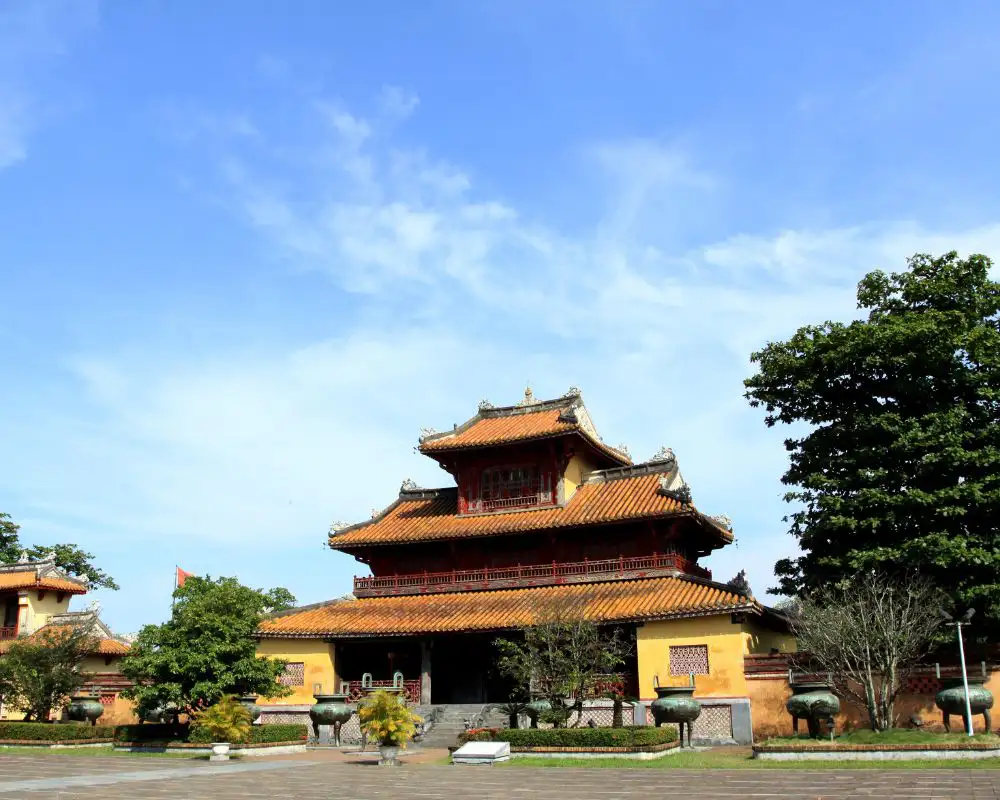
The pavilion is a three-story wooden structure, featuring ornate carvings and traditional decorations. Its elevated design symbolizes the high regard for the ancestors it commemorates.
Hien Lam Pavilion houses numerous historical artifacts, including royal edicts, decrees, and ceremonial objects. These artifacts provide valuable insights into the administrative and ceremonial practices of the Nguyen Dynasty.
9. Royal Gardens
The Royal Gardens within Hue Citadel are meticulously designed to reflect the harmony and beauty of nature. These gardens include a variety of plants, flowers, and trees, arranged in aesthetically pleasing layouts.
Key features of the Royal Gardens include ornamental lakes, stone bridges, and pavilions. These elements create a tranquil environment that complements the architectural grandeur of the Citadel.
The gardens were an important aspect of court life, providing a serene retreat for the emperor and his court. They reflect the Nguyen Dynasty’s appreciation for nature and beauty.
10. Minh Mang Tomb
The Tomb of Emperor Minh Mang, located near Hue, was constructed between 1840 and 1843. It is one of the most majestic royal tombs, reflecting the emperor’s vision and legacy.
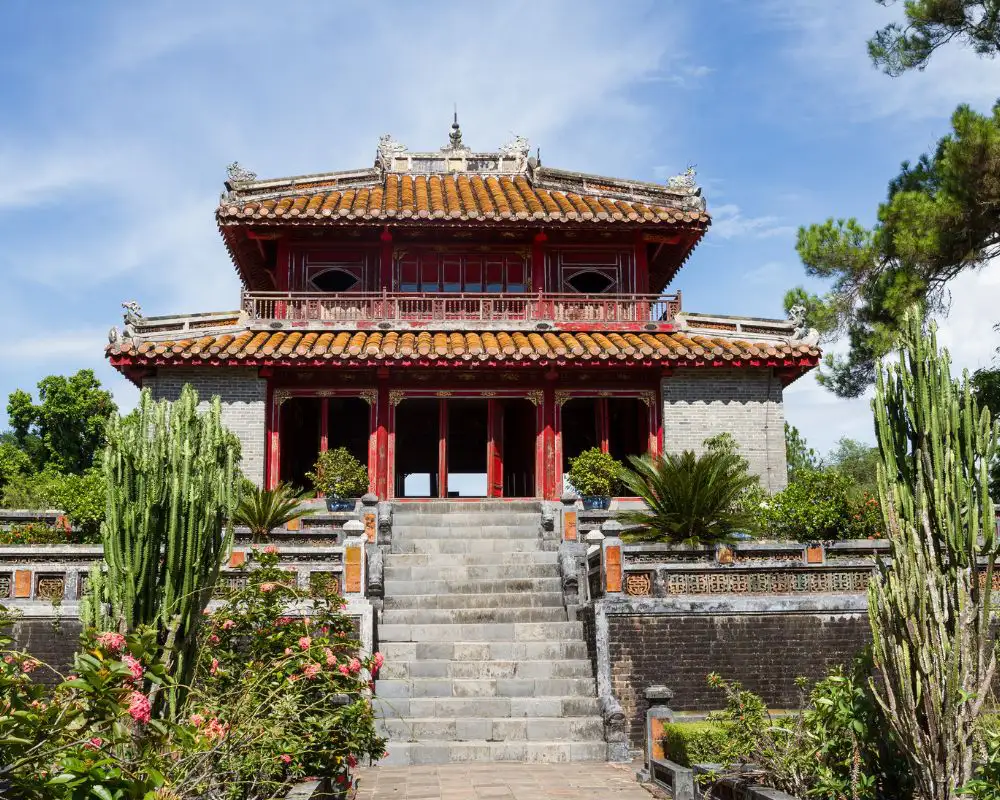
The tomb complex features a harmonious blend of architecture and natural landscape. It includes palaces, temples, pavilions, and a serene lake, all arranged symmetrically.
Emperor Minh Mang was the second emperor of the Nguyen Dynasty, known for his administrative reforms and efforts to strengthen the central government. His tomb is a testament to his achievements and vision for Vietnam.
11. Khai Dinh Tomb
The Tomb of Emperor Khai Dinh, completed in 1931, is the final resting place of the 12th emperor of the Nguyen Dynasty. It is known for its unique blend of Vietnamese and European architectural styles.
The tomb’s design incorporates traditional Vietnamese elements with influences from French and Roman architecture. It features elaborate mosaics, intricate stone carvings, and a grand staircase leading to the main hall.
Emperor Khai Dinh was known for his efforts to modernize Vietnam, and his tomb reflects his cosmopolitan outlook. The tomb’s distinctive architecture sets it apart from other royal tombs in Hue.
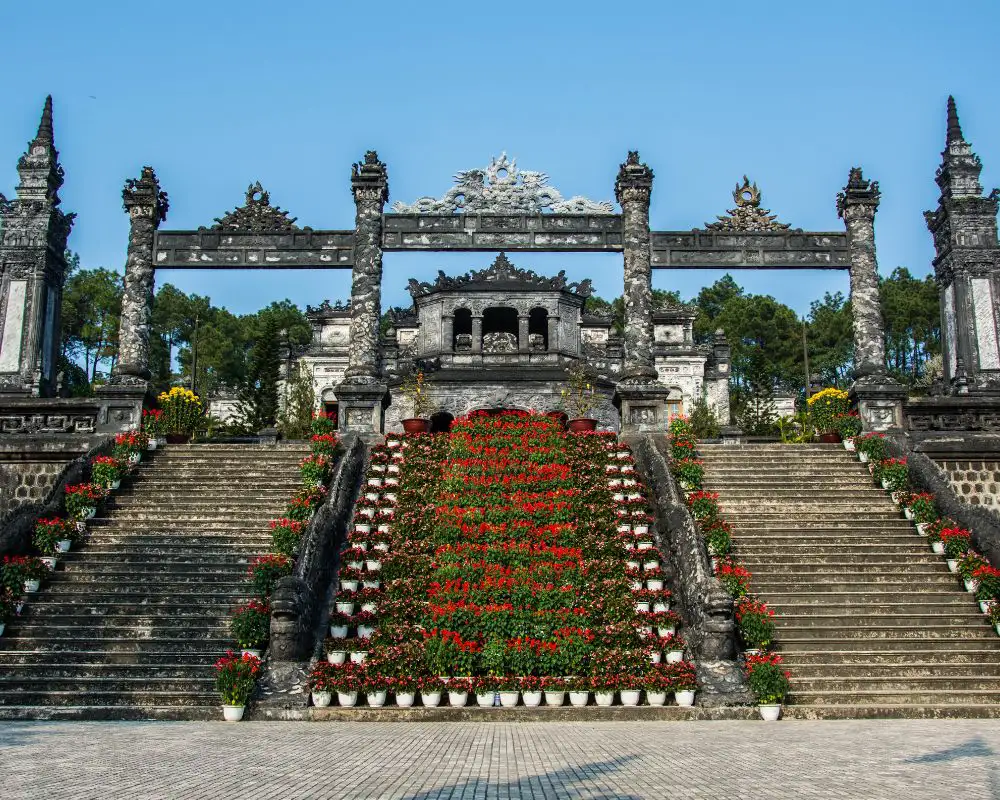
12. Thien Mu Pagoda
Thien Mu Pagoda, also known as the Pagoda of the Celestial Lady, is one of the oldest and most iconic pagodas in Vietnam. It was founded in 1601 and has since become a symbol of Hue.
The pagoda features a seven-story tower, each level dedicated to a different Buddha. The complex includes several temples, statues, and a beautiful garden overlooking the Perfume River.
Thien Mu Pagoda holds great cultural and religious significance. It has been a center for Buddhist worship and learning for centuries, attracting pilgrims and tourists alike.
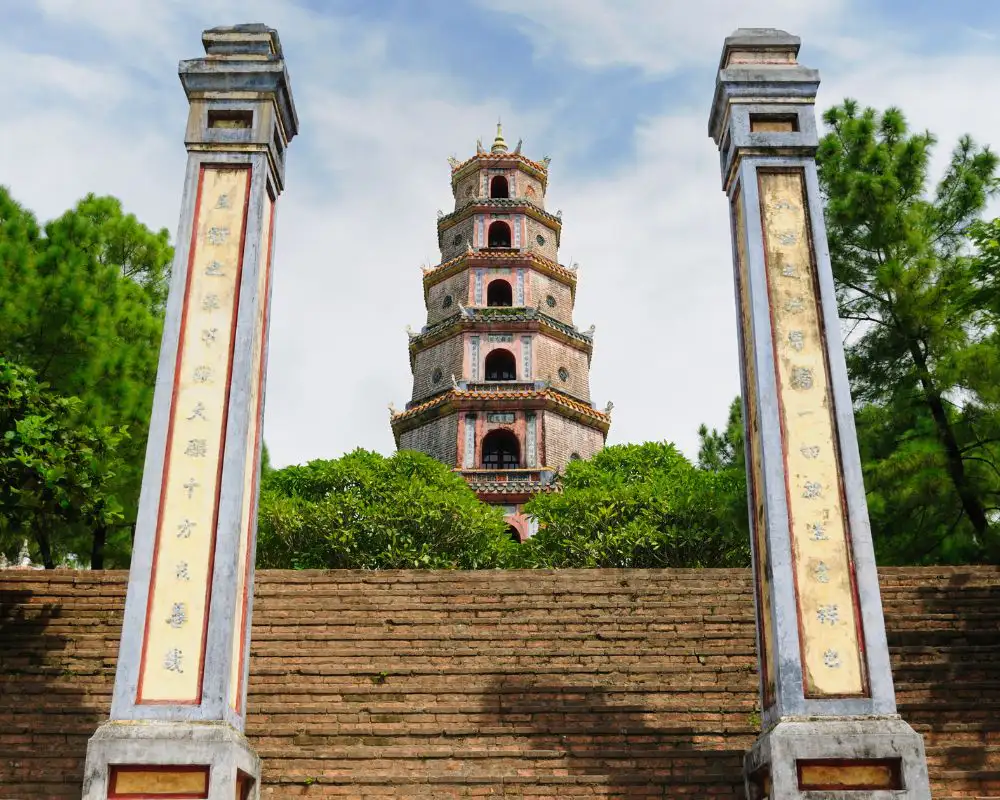
How Much Time to Visit Hue Imperial City?
If you are short on time, a half-day visit (approximately 3-4 hours) can cover the highlights of the Imperial City. Focus on the most significant sites like Ngo Mon Gate, Thai Hoa Palace, and a quick tour of the Forbidden Purple City.
Hue imperial city tour becomes truly special with a guide who shares captivating stories and detailed information, making your journey even richer and longer. Remember, the Nguyen Dynasty spanned 143 years, and there is so much to discover!
You can refer to some our program tours:
- Danang Ba Na hills & Hue city tour full day
- Danang – Hoian – Ba Na Hills – Hue Imperial City Tour 3D2N
- Danang – Phong Nha Cave – DMZ – Hue Citadel & Ba Na Hills 4D3N
- Danang – My Son Sanctuary – Hoian – Hue – Ba Na Hills Tour 3D2N
Best Time to Visit Hue Historic Citadel
Because the Citadel closes at approximately 5 p.m., your visit should take place in the morning or early afternoon to give you more time to explore the construction.
In addition, the best time to visit Hue Imperial City is during the dry season, from March to August. The weather is more predictable, making it ideal for exploring outdoor attractions. However, the city can be visited year-round, with each season offering a unique experience.
Besides, visiting during the Hue Festival, held biennially, can provide a unique cultural experience. The festival features traditional performances, parades, and exhibitions that bring the city’s history to life.
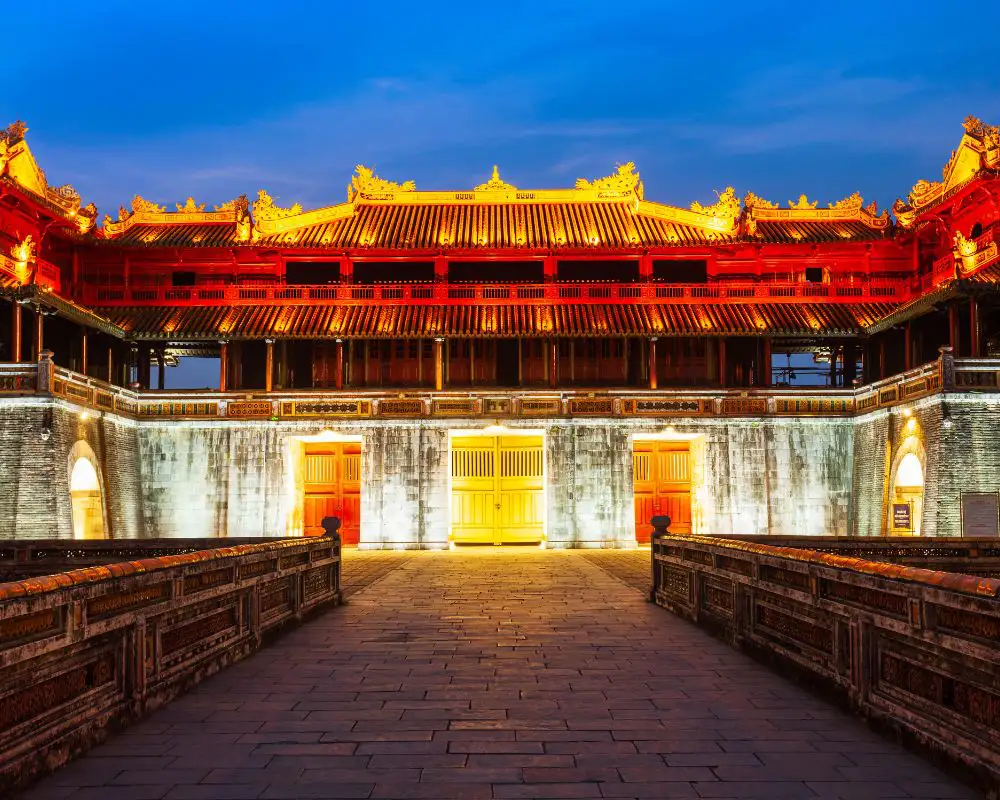
How to get to Hue Imperial Citadel?
Flights
Phu Bai International Airport
Hue is served by Phu Bai International Airport (HUI), located about 15 kilometers south of the city center. Several domestic airlines, including Vietnam Airlines, VietJet Air, and Bamboo Airways, offer regular flights to Hue from major cities like Hanoi, Ho Chi Minh City, and Danang.
- From Hanoi: Approximately 1 hour and 15 minutes
- From Ho Chi Minh City: Approximately 1 hour and 30 minutes
- From Danang: Approximately 1 hour
Read more: How can get from Ho Chi Minh to Danang?
From the Airport to the City Center
You can take a taxi or a shuttle bus from Phu Bai International Airport to the city center. Taxis are readily available and provide a direct and convenient option. The journey typically takes around 30 minutes. Shuttle buses offer a more budget-friendly alternative and run at regular intervals.
Trains
Hue is a major stop on the Reunification Express, the train route that runs from Hanoi to Ho Chi Minh City. Traveling by train offers scenic views of the Vietnamese countryside and coastline. Trains arrive at Hue Railway Station, which is located about 3 kilometers from the Imperial Citadel.
- From Hanoi: Approximately 13-14 hours
- From Ho Chi Minh City: Approximately 18-19 hours
- From Da Nang: Approximately 2.5-3 hours
Buses
Several bus companies operate routes to Hue from various cities in Vietnam. Sleeper buses are a popular option for long-distance travel, providing a comfortable and affordable way to reach Hue. Buses typically arrive at the Southern Bus Station (Bến xe phía Nam), located about 5 kilometers from the city center.
- From Hanoi: Approximately 13-14 hours
- From Ho Chi Minh City: Approximately 24 hours
- From Da Nang: Approximately 3-4 hours
From Hue to ancient imperial city of Hue
Taxis
Taxis are a convenient and readily available option for getting to the Hue Imperial Citadel from anywhere in the city. Major taxi companies in Hue include Mai Linh and Vinasun. Ensure the driver uses the meter or agree on a fare before starting your journey.
Cyclos
Cyclos (three-wheeled bicycle taxis) offer a unique and traditional way to travel short distances in Hue. They are particularly popular among tourists for their leisurely pace and the opportunity to take in the sights. Cyclo rides can be negotiated directly with the driver.
Walking
If you are staying near the city center or along the Perfume River, walking to the Citadel can be a pleasant option. The Citadel is located within walking distance of many hotels and attractions. Walking also allows you to explore the charming streets of Hue at your own pace.
Souvenirs and Shopping at Hue Citadel
Conical Hats
The non la (conical hat) is a quintessential Vietnamese souvenir. In Hue, these hats are often intricately decorated with poems, paintings, or images that can be seen when held up to the light. They are a beautiful and practical keepsake that represents Vietnamese culture.
Silk Products
Hue is known for its high-quality silk products, including scarves, ties, and ao dai (traditional Vietnamese dresses). These items are often hand-embroidered with intricate designs, making them a perfect gift or personal souvenir.
Bamboo Items
Bamboo crafts are another popular choice for souvenirs. These include baskets, trays, and various decorative items made by local artisans. Bamboo products are lightweight, eco-friendly, and showcase the craftsmanship of the local people.
Incense
Incense making is a traditional craft in Hue. You can find beautifully scented incense sticks in various colors and sizes, often packaged in decorative boxes. They make a thoughtful and aromatic gift.
Bronze Castings
Bronze casting is an ancient art form in Hue, with items ranging from small figurines to intricate statues and household items. These pieces are not only beautiful but also represent the skilled craftsmanship passed down through generations.
Wood Carvings
Wood carvings are another specialty of Hue. Artisans create detailed sculptures, decorative panels, and everyday items like chopsticks and bowls. These carvings often depict scenes from Vietnamese mythology and daily life.
Paintings
Hue is home to many talented artists who create beautiful paintings reflecting the city’s landscapes, historical sites, and cultural heritage. These artworks are available in galleries and shops throughout the city.
Ceramics
Ceramic items, such as vases, bowls, and plates, are popular souvenirs in Hue. They are often hand-painted with traditional designs and make excellent decorative pieces for your home.
Antique Shops
For those interested in history, antique shops in Hue offer a variety of items, including old coins, pottery, and other relics. These unique finds provide a tangible connection to the past.
Local Markets
Dong Ba Market
Dong Ba Market is the largest and most famous market in Hue. Here, you can find many goods, from fresh produce and local delicacies to clothing and souvenirs. It’s a bustling place where you can experience the local culture and shop for unique items.
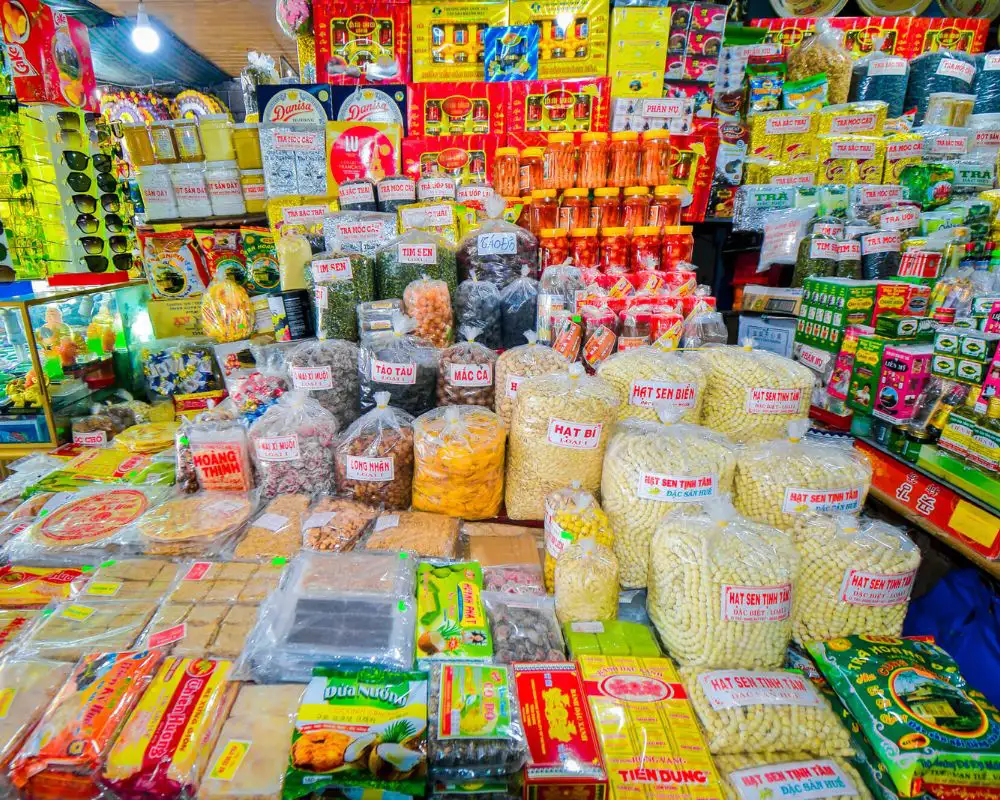
Night Market
The night market in Hue is a vibrant place to shop for souvenirs, try local street food, and enjoy the lively atmosphere. It’s a great place to find handmade crafts and bargain for the best prices.
An Cuu Market
An Cuu Market is a bit smaller and more local than Dong Ba Market. It offers a variety of goods, including fresh food, clothing, and household items. It’s an excellent spot to find everyday essentials and unique local products.
Tips for Travelers
Pack lightweight, breathable clothing suitable for Hue’s tropical climate. Comfortable walking shoes are essential for exploring the Citadel and other attractions. Don’t forget sunscreen, a hat, and insect repellent.
Hue is generally a safe city for tourists, but it’s always wise to stay vigilant. Keep your belongings secure, especially in crowded places. Avoid walking alone late at night and use reputable transport services.
Respect local customs by dressing code modestly, especially when visiting temples and religious sites. Remove your shoes before entering homes and certain buildings. Learn a few basic Vietnamese phrases to show respect and friendliness.

